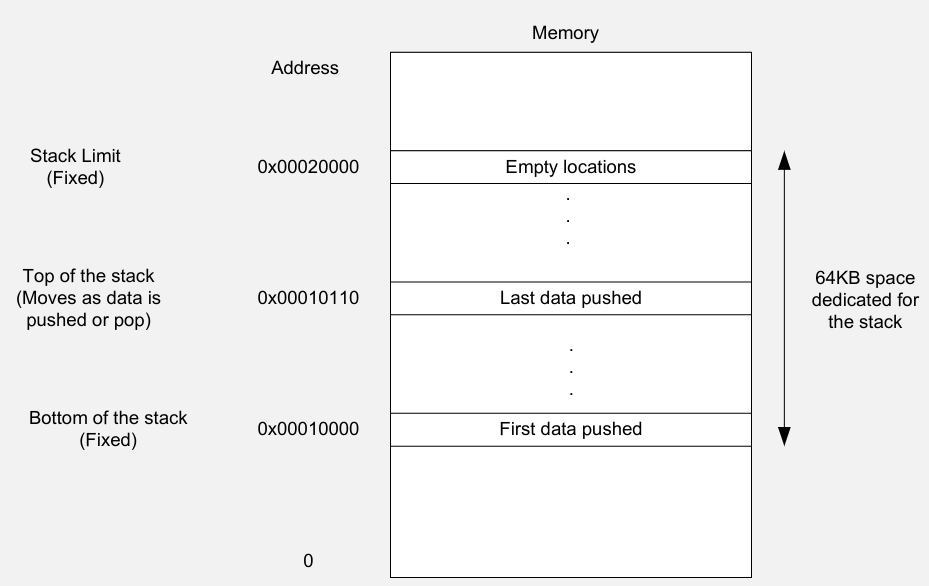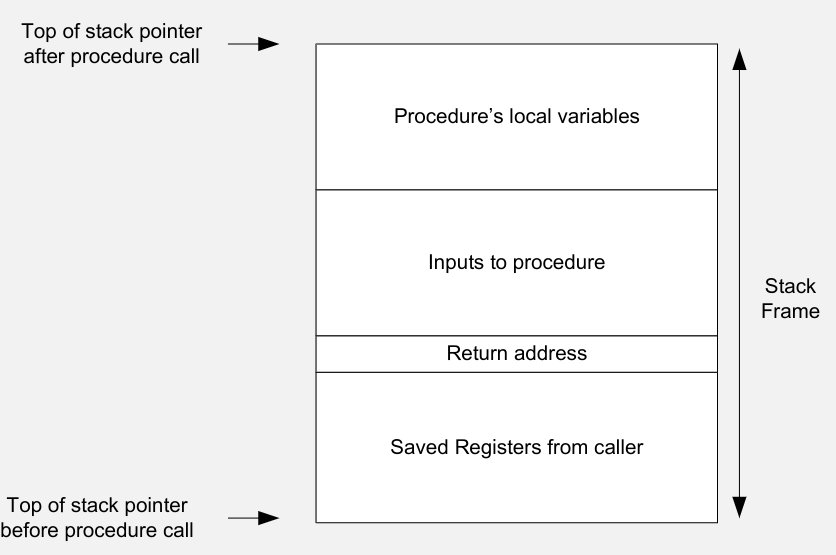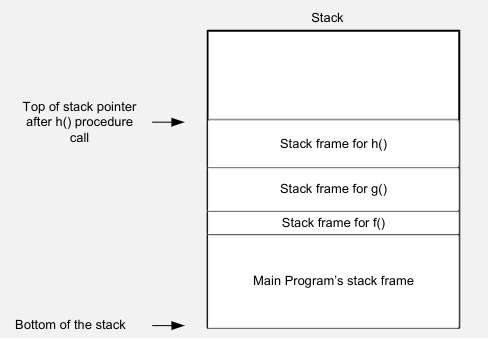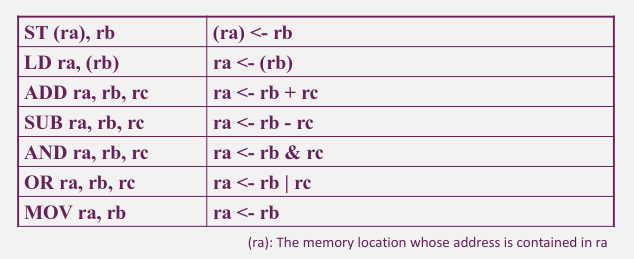20 KiB
20 KiB
- #CT213 - Computer Systems & Organisation
- Previous Topic: Overview of Computer Systems
- Relevant Slides:
- What is a Processor Programming Model? #card
card-last-interval:: -1
card-repeats:: 1
card-ease-factor:: 2.46
card-next-schedule:: 2022-11-15T00:00:00.000Z
card-last-reviewed:: 2022-11-14T16:46:41.751Z
card-last-score:: 1
- A Processor Programming Model defines ^^how instructions access their operands and how instructions are described in the processor's assembly language.^^
- Processors with different programming models can offer similar sets of operations but may require very different approaches to programming.
-
Instructions
- What is the Instruction Cycle? #card
card-last-interval:: 33.64
card-repeats:: 4
card-ease-factor:: 2.9
card-next-schedule:: 2022-12-18T07:51:49.011Z
card-last-reviewed:: 2022-11-14T16:51:49.012Z
card-last-score:: 5
- The Instruction Cycle is the ^^procedure of processing an instruction^^ by the microprocessor.
- Fetch: read the instructions from memory
- Decode: Determine what is to be done
- Execute: Perform the operation
- Each of the functions fetch -> decode -> execute consist of a sequence of one or more operations inside the CPU (and interaction with the subsystems).
- The Instruction Cycle is the ^^procedure of processing an instruction^^ by the microprocessor.
-
Types of Instructions
-
Data Transfer Instructions
- What are Data Transfer Instructions? #card
card-last-interval:: 33.64
card-repeats:: 4
card-ease-factor:: 2.9
card-next-schedule:: 2022-12-18T07:51:37.887Z
card-last-reviewed:: 2022-11-14T16:51:37.888Z
card-last-score:: 5
- Operations that ^^move data^^ from one place to another.
- These instructions ^^don't modify^^ the data, they just copy it to the destination.
- What operations can data transfer instructions do? #card
card-last-interval:: -1
card-repeats:: 1
card-ease-factor:: 2.46
card-next-schedule:: 2022-11-15T00:00:00.000Z
card-last-reviewed:: 2022-11-14T16:33:36.553Z
card-last-score:: 1
- card-last-interval:: -1
card-repeats:: 1
card-ease-factor:: 2.7
card-next-schedule:: 2022-11-15T00:00:00.000Z
card-last-reviewed:: 2022-11-14T16:40:37.309Z
card-last-score:: 1
- Load data from memory into the microprocessor. #card
- These instructions copy data from memory into microprocessor registers (i.e., LD).
- card-last-interval:: 29.26
card-repeats:: 4
card-ease-factor:: 2.66
card-next-schedule:: 2022-12-13T22:48:21.927Z
card-last-reviewed:: 2022-11-14T16:48:21.927Z
card-last-score:: 5
2. Store data from the microprocessor into the memory. #card
- Similar to load data, except that the data is copied in the opposite direction (i.e., ST).
- Data is saved from internal microprocessor registers into the memory
- card-last-interval:: 11.2
card-repeats:: 3
card-ease-factor:: 2.8
card-next-schedule:: 2022-10-14T18:29:32.655Z
card-last-reviewed:: 2022-10-03T14:29:32.655Z
card-last-score:: 5
3. Move data within the microprocessor.
- These instructions move data from one microprocessor register to another (i.e., MOV)
- card-last-interval:: 4
card-repeats:: 2
card-ease-factor:: 2.7
card-next-schedule:: 2022-09-23T17:44:07.730Z
card-last-reviewed:: 2022-09-19T17:44:07.731Z
card-last-score:: 5
4. Input data into the microprocessor.
- A microprocessor may need to input data from the outside world.
- These are the instructions that input data from the input device into the microprocessor.
- A microprocessor may need to input data from the outside world.
- card-last-interval:: 4
card-repeats:: 2
card-ease-factor:: 2.7
card-next-schedule:: 2022-09-23T17:47:33.165Z
card-last-reviewed:: 2022-09-19T17:47:33.165Z
card-last-score:: 5
5. Output data from the microprocessor.
- The microprocessor copies data from one of its internal registers to an output device.
- Example: the microprocessor may want to show the content of an internal register on a display (the key has been pressed) (i.e., IOWR).
- card-last-interval:: -1
card-repeats:: 1
card-ease-factor:: 2.7
card-next-schedule:: 2022-11-15T00:00:00.000Z
card-last-reviewed:: 2022-11-14T16:40:37.309Z
card-last-score:: 1
- What are Data Transfer Instructions? #card
card-last-interval:: 33.64
card-repeats:: 4
card-ease-factor:: 2.9
card-next-schedule:: 2022-12-18T07:51:37.887Z
card-last-reviewed:: 2022-11-14T16:51:37.888Z
card-last-score:: 5
-
Data Operation Instructions #card
card-last-interval:: -1 card-repeats:: 1 card-ease-factor:: 2.56 card-next-schedule:: 2022-11-15T00:00:00.000Z card-last-reviewed:: 2022-11-14T16:47:54.439Z card-last-score:: 1- Instructions that do modify their data values.
- They typically perform some operation (e.g., +, -, *) using one or two data values (operands) and store the result.
- What operations can data operation instructions do? #card
card-last-interval:: 30.47
card-repeats:: 4
card-ease-factor:: 2.76
card-next-schedule:: 2022-12-15T07:20:59.244Z
card-last-reviewed:: 2022-11-14T20:20:59.245Z
card-last-score:: 5
- Arithmetic Instructions #card
card-last-interval:: 4
card-repeats:: 2
card-ease-factor:: 2.9
card-next-schedule:: 2022-11-27T12:19:15.119Z
card-last-reviewed:: 2022-11-23T12:19:15.119Z
card-last-score:: 5
- add, subtract, multiply, or divide
- ADD, SUB, MUL, DIV
- Instructions that increment or decrement one from a value
- INC, DEC
- Floating point instructions that operate on floating point values
- FADD, FSUB, FMUL, FDIV
- add, subtract, multiply, or divide
- Logic Instructions
card-last-interval:: 11.2
card-repeats:: 3
card-ease-factor:: 2.8
card-next-schedule:: 2022-10-14T15:43:49.421Z
card-last-reviewed:: 2022-10-03T11:43:49.421Z
card-last-score:: 5
- AND, OR, XOR, NOT, etc.
- Shift Instructions
card-last-interval:: 10.92
card-repeats:: 3
card-ease-factor:: 2.46
card-next-schedule:: 2022-10-11T06:45:44.876Z
card-last-reviewed:: 2022-09-30T08:45:44.877Z
card-last-score:: 5
- SR, SL, RR, RL, etc.
- Arithmetic Instructions #card
card-last-interval:: 4
card-repeats:: 2
card-ease-factor:: 2.9
card-next-schedule:: 2022-11-27T12:19:15.119Z
card-last-reviewed:: 2022-11-23T12:19:15.119Z
card-last-score:: 5
-
Program Control Instructions #card
card-last-interval:: 31.36 card-repeats:: 4 card-ease-factor:: 2.8 card-next-schedule:: 2022-12-16T00:29:50.214Z card-last-reviewed:: 2022-11-14T16:29:50.214Z card-last-score:: 5- Jump or branch instructions are used to ^^go to another part of the program^^; Jumps can be absolute or conditional.
- e.g., if, then, else.
- Instructions that can generate interrupts.
- Software interrupts.
- Jump & branch instructions (conditional or unconditional)
card-last-interval:: 11.2
card-repeats:: 3
card-ease-factor:: 2.8
card-next-schedule:: 2022-10-14T18:27:30.317Z
card-last-reviewed:: 2022-10-03T14:27:30.317Z
card-last-score:: 5
- JZ: Jump if the zero flag is set.
- JNZ: Jump if the zero flag is not set.
- JMP: Unconditional jump - flags are ignored.
- etc.
- Comparison Instructions #card
card-last-interval:: 28.3
card-repeats:: 4
card-ease-factor:: 2.66
card-next-schedule:: 2022-12-09T18:30:16.818Z
card-last-reviewed:: 2022-11-11T11:30:16.819Z
card-last-score:: 5
- TEST: logical BITWISE AND
- Calls & Returns a / from a routine (conditional or unconditional) #card
card-last-interval:: 4
card-repeats:: 2
card-ease-factor:: 2.66
card-next-schedule:: 2022-11-18T20:24:48.750Z
card-last-reviewed:: 2022-11-14T20:24:48.750Z
card-last-score:: 5
- Call: call a subroutine at a certain line.
- RET: return from a subroutine.
- IRET: interrupt & return.
- Software Interrupts #card
card-last-interval:: 33.64
card-repeats:: 4
card-ease-factor:: 2.9
card-next-schedule:: 2022-12-18T10:59:57.740Z
card-last-reviewed:: 2022-11-14T19:59:57.740Z
card-last-score:: 5
- Generated by devices outside of a microprocessor (not part of the instruction set).
- INT
- Exceptions & Traps #card
card-last-interval:: 11.2
card-repeats:: 3
card-ease-factor:: 2.8
card-next-schedule:: 2022-11-26T00:12:13.565Z
card-last-reviewed:: 2022-11-14T20:12:13.565Z
card-last-score:: 5
- Triggered when valid instructions perform invalid operations.
- e.g., dividing by zero.
- Triggered when valid instructions perform invalid operations.
- Halt Instructions #card
card-last-interval:: 33.64
card-repeats:: 4
card-ease-factor:: 2.9
card-next-schedule:: 2022-12-18T07:49:58.118Z
card-last-reviewed:: 2022-11-14T16:49:58.118Z
card-last-score:: 5
- Causes the processor to stop executions.
- e.g., at the end of the program.
- HALT
- Causes the processor to stop executions.
- Jump or branch instructions are used to ^^go to another part of the program^^; Jumps can be absolute or conditional.
-
- What is the Instruction Cycle? #card
card-last-interval:: 33.64
card-repeats:: 4
card-ease-factor:: 2.9
card-next-schedule:: 2022-12-18T07:51:49.011Z
card-last-reviewed:: 2022-11-14T16:51:49.012Z
card-last-score:: 5
-
Stack Architectures
-
The Stack
- Last In First Out (LIFO) data structure.
- Consists of locations, each of which can hold a word of data.
- It can be used to explicitly save / restore data.
- What operations does the stack support? #card
card-last-interval:: 33.64
card-repeats:: 4
card-ease-factor:: 2.9
card-next-schedule:: 2022-12-18T11:00:04.531Z
card-last-reviewed:: 2022-11-14T20:00:04.532Z
card-last-score:: 5
- The stack supports ^^two operations.^^
- PUSH: takes one argument and places the value of the argument at the top of the stack.
- POP: removes one element from the stack, saving it into a predefined register of the processor.
- The stack supports ^^two operations.^^
- The stack is ^^used implicitly by procedure call instructions.^^
- (if available in the data set).
- When new data is added to the stack, it is placed at the top of the stack, and all of the contents of the stack are pushed down one location.
-
Implementing Stacks
- What are the two ways to implement a stack? #card
card-last-interval:: 41.44
card-repeats:: 5
card-ease-factor:: 2.18
card-next-schedule:: 2022-12-20T22:45:42.001Z
card-last-reviewed:: 2022-11-09T12:45:42.002Z
card-last-score:: 3
- card-last-interval:: 7.76
card-repeats:: 3
card-ease-factor:: 1.94
card-next-schedule:: 2022-11-22T10:43:10.114Z
card-last-reviewed:: 2022-11-14T16:43:10.114Z
card-last-score:: 3
- Dedicated Hardware Stack #card
- Has a ^^hardware limitation^^ (limited number of locations).
- Very fast.
- card-last-interval:: 28.3
card-repeats:: 4
card-ease-factor:: 2.66
card-next-schedule:: 2022-12-12T23:52:10.829Z
card-last-reviewed:: 2022-11-14T16:52:10.829Z
card-last-score:: 3
2. Memory Implemented Stack #card
- Limited by the ^^physical memory of the system.^^
- Slow compared with hardware stacks, since extra memory addressing has to take place for each stack operation.
 {:height 405, :width 638}
{:height 405, :width 638}- Every push operation will ^^increment the top of the stack pointer^^ with the word size of the machine.
- Every pop operation will ^^decrement the top of the stack pointer^^ (with the word size of the machine).
- card-last-interval:: 7.76
card-repeats:: 3
card-ease-factor:: 1.94
card-next-schedule:: 2022-11-22T10:43:10.114Z
card-last-reviewed:: 2022-11-14T16:43:10.114Z
card-last-score:: 3
- Stack overflows can occur in both stack implementations
- What is a stack overflow? #card
card-last-interval:: 97.56
card-repeats:: 5
card-ease-factor:: 2.9
card-next-schedule:: 2023-02-20T09:22:00.580Z
card-last-reviewed:: 2022-11-14T20:22:00.581Z
card-last-score:: 5
- A stack overflow occurs when the amount of data in the stack exceeds the amount of space allocated to the stack (or the hardware limit of the stack).
- What is a stack overflow? #card
card-last-interval:: 97.56
card-repeats:: 5
card-ease-factor:: 2.9
card-next-schedule:: 2023-02-20T09:22:00.580Z
card-last-reviewed:: 2022-11-14T20:22:00.581Z
card-last-score:: 5
- What are the two ways to implement a stack? #card
card-last-interval:: 41.44
card-repeats:: 5
card-ease-factor:: 2.18
card-next-schedule:: 2022-12-20T22:45:42.001Z
card-last-reviewed:: 2022-11-09T12:45:42.002Z
card-last-score:: 3
-
Instructions in Stack-Based Architecture #card
card-last-interval:: 33.96 card-repeats:: 5 card-ease-factor:: 2.04 card-next-schedule:: 2022-12-18T19:21:47.052Z card-last-reviewed:: 2022-11-14T20:21:47.052Z card-last-score:: 5- Instructions in a stack-base architecture get their operands from the stack and write their results to the stack.
- The advantage of this is that ^^program code takes little memory - there is no need to specify the address of the operands or registers.^^
- PUSH is one exception, because it needs the operand to be specified (either as a constant or as an address).
-
Programs in a Stack-Based Architecture
- Writing programs for stack-based architecture is not easy.
- Stack-based architectures are better suited for postfix notation rather than infix notation.
- What is infix notation? #card
card-last-interval:: 33.64
card-repeats:: 4
card-ease-factor:: 2.9
card-next-schedule:: 2022-12-18T07:51:56.638Z
card-last-reviewed:: 2022-11-14T16:51:56.639Z
card-last-score:: 5
- Infix notation is the traditional way of representing mathematical expressions, with ^^operations placed between the operands.^^
- e.g., a + b
- Infix notation is the traditional way of representing mathematical expressions, with ^^operations placed between the operands.^^
- What is postfix notation? #card
card-last-interval:: 33.64
card-repeats:: 4
card-ease-factor:: 2.9
card-next-schedule:: 2022-12-18T07:50:12.717Z
card-last-reviewed:: 2022-11-14T16:50:12.718Z
card-last-score:: 5
- In postfix notation, ^^the operation is placed after the operands.^^
- e.g., a b +
- Stack-based architectures are better suited for postfix notation.
- Once an expression has been converted into postfix notation, implementing it in programs is easy.
- In postfix notation, ^^the operation is placed after the operands.^^
- Writing programs for stack-based architecture is not easy.
-
Using Stacks to Implement Procedure Calls
- Programs need a way to pass inputs to the procedures that they call and to receive outputs back from them.
- Procedures need to be able to allocate space in memory for local variables without overriding any data used by their calling program.
- It is impossible to determine which registers may be used safely by the procedure (especially if the procedure is located in a library).
- So, a mechanism to save / restore registers of the calling program has to be in place.
- Procedures need a way to figure out where they were called from.
- So, the execution can return to the calling program where the procedure completes (they need to restore the program counter).
- How are procedure calls implemented in Stacks? #card
card-last-interval:: 19.01
card-repeats:: 4
card-ease-factor:: 2.18
card-next-schedule:: 2022-12-03T20:06:14.181Z
card-last-reviewed:: 2022-11-14T20:06:14.181Z
card-last-score:: 3

- When a procedure is called,^^a block of memory in the stack called a stack frame is allocated.^^
- The top of the stack pointer is incremented by the number of locations in the stack frame.
- When a procedure finishes, it jumps to the return address of the stack and the execution of the calling program resumes.
- How are nested procedure calls implemented in the stack? #card card-last-interval:: 47.41 card-repeats:: 5 card-ease-factor:: 2.28 card-next-schedule:: 2023-01-01T05:23:12.594Z card-last-reviewed:: 2022-11-14T20:23:12.594Z card-last-score:: 5
-
-
General-Purpose Register Architectures
-
General-Purpose Register File
- In GPR Architectures, instructions read their operands and write their results to a random access register file.
- The general-purpose register file allows the ^^access of any register in any order^^ by specifying the number (register ID) of the register.
- What is the main difference between a GPR & a stack? #card
card-last-interval:: 23.43
card-repeats:: 4
card-ease-factor:: 2.42
card-next-schedule:: 2022-12-08T02:44:31.512Z
card-last-reviewed:: 2022-11-14T16:44:31.512Z
card-last-score:: 5
- The main difference between a GPR and a stack is that repeatedly reading a register will produce the same result and will not modify the state of the register file.
- Popping an item from a LIFO structure (stack) will modify the contents of the stack,
- The main difference between a GPR and a stack is that repeatedly reading a register will produce the same result and will not modify the state of the register file.
- Many GPR architectures assign special values to some registers in the register file to make programming easier.
- e.g., sometimes, register 0 is hardwired with value 0 to generate this most common constant.
-
Instructions in GPR Architecture
- What do GPR instructions need to specify? #card
card-last-interval:: 41.44
card-repeats:: 5
card-ease-factor:: 2.18
card-next-schedule:: 2022-12-30T04:36:58.493Z
card-last-reviewed:: 2022-11-18T18:36:58.494Z
card-last-score:: 3
- GPR instructions need to specify:
- the register that holds their input operands
- the register that will hole the result
- GPR instructions need to specify:
- What is the most common GPR instruction format? #card
card-last-interval:: -1
card-repeats:: 1
card-ease-factor:: 2.56
card-next-schedule:: 2022-11-15T00:00:00.000Z
card-last-reviewed:: 2022-11-14T20:01:45.936Z
card-last-score:: 1
- The most common GPR instruction format is the three operands instruction format.
- e.g., "ADD r1, r2, r3" instructs the processor to read the contents of r2 and r3, add them together, and write the results in r1.
- Instructions that only have one or two inputs are also present in GPR architecture.
- The most common GPR instruction format is the three operands instruction format.
- Which architecture allows caching? #card
card-last-interval:: 33.64
card-repeats:: 4
card-ease-factor:: 2.9
card-next-schedule:: 2022-12-18T07:38:25.742Z
card-last-reviewed:: 2022-11-14T16:38:25.742Z
card-last-score:: 5
- In GPR Architecture, ^^programs can choose which values should be stored in the register file at any given time^^, allowing them to cache the most accessed data.
- In stack-based architectures, once the data has been used, it's gone.
- From this point of view, ^^GPR architectures have better performance^^, at the expense of needing more storage space for the program.
- larger instructions are needed to encode the addresses of the operands.
-
Simple GPR Instruction Set
- What do GPR instructions need to specify? #card
card-last-interval:: 41.44
card-repeats:: 5
card-ease-factor:: 2.18
card-next-schedule:: 2022-12-30T04:36:58.493Z
card-last-reviewed:: 2022-11-18T18:36:58.494Z
card-last-score:: 3
-
Programs in a GPR Architecure #card
card-last-interval:: 28.3 card-repeats:: 4 card-ease-factor:: 2.66 card-next-schedule:: 2022-12-15T16:48:41.651Z card-last-reviewed:: 2022-11-17T09:48:41.652Z card-last-score:: 5- Programming a GPR architecture processor is less structured than programming a stack-based architecture processor.
- There are fewer restrictions on the order in which operations can be executed.
- In stack-based architectures, instructions must execute in the order that would leave the operands for the next instructions on the top of the stack.
- In GPR, any order that places the operands for the next instruction in the register file before the instruction executes is valid.
- Operations that access different registers can be reordered without making the program invalid.
- There are fewer restrictions on the order in which operations can be executed.
- Programming a GPR architecture processor is less structured than programming a stack-based architecture processor.
-
-
Stack-Bases vs GPR Architectures
- Stack-based architectures are still attractive for certain embedded systems.
- GPR architectures are used by modern computers.
-
Stack-Based Architectures #card
card-last-interval:: 24.2 card-repeats:: 4 card-ease-factor:: 2.42 card-next-schedule:: 2022-12-11T13:48:46.669Z card-last-reviewed:: 2022-11-17T09:48:46.669Z card-last-score:: 3- Instructions take fewer bits to encode.
- Reduced amount of memory taken up by programs.
- Manages the use of registers automatically (no need for programmer intervention).
- The instruction set does not change if the size of the register file has changed.
-
GPR Architectures
- With the evolution of technology, the amount of space taken up by a program is less important.
- Compilers for GPR architecture achieve better performance with a given number of general-purpose registers than those on stack-based architectures with the same number of registers.
- The compiler can choose which values to keep (cache) in the register file at any time.


